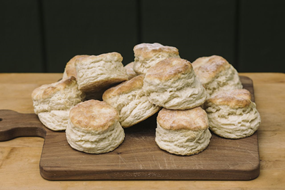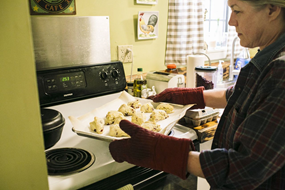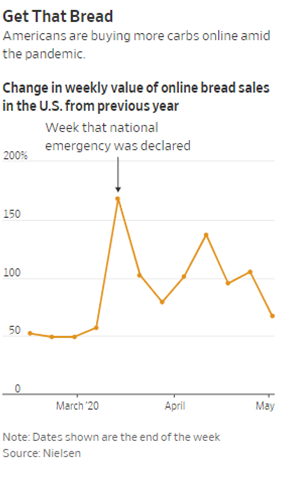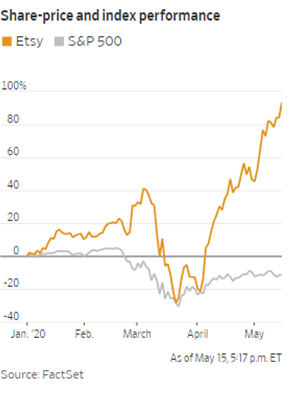THE
WALL STREET JOURNAL.
|
How Etsy
Became America’s Unlikeliest Breadbasket
Homebound
consumers are flocking to the site for scones, biscuits,
breads, muffins, doughnuts and...alkaline tahini spelt
cookies. Homebound chefs are eager to satisfy this newfound
hunger for baked goods.
|
 |
|
|
Suzanne McMinn
bakes cookies, scones, biscuits, muffins and breads in her
home kitchen, and mails them to all corners of the U.S. ANDREW
SPEAR FOR THE WALL STREET JOURNAL |
Just about every morning since
America went on coronavirus lockdown, Suzanne McMinn has risen at 2 a.m. to bake
in her home kitchen. She’s working there up to 15 hours a day, seven days a
week.
But she’s not cooking for herself,
mostly. She’s cranking out dozens of orders daily for people all over the
U.S.—people who found her on Etsy.
Yes,
she sells bread on the site best known for knitted
hats and topical
greeting cards and, lately, hand-sewn
masks.
 |
 |
|
Ms. McMinn made scones and biscuits in her
kitchen on Wednesday. Lately she’s been baking up to 15 hours a day, seven
days a week. PHOTOS: ANDREW
SPEAR FOR THE WALL STREET JOURNAL(2) |
On her farm in Roane County, W.Va.,
Ms. McMinn has cows, a dozen chickens and a kitchen in which she bakes cookies,
scones, biscuits, muffins and breads. She works alone but is hardly singular.
Thousands of her peers all across the country do what she does, every day: sell
the products of their humble home kitchens on the internet.
For most of America’s history,
people’s food came from no more than a few miles away, the distance a farmer
could travel in a horse-drawn wagon. During the Great Depression, rural farms
were an important source of food security for the country, a way for people to
feed themselves despite their poverty.
In these uncertain times, Americans
are once again taking solace in food. But the horse-drawn wagons have been
replaced by FedEx jets
and trucks, and the “penny restaurants” of yore have been replaced by
internet-savvy entrepreneurs who have discovered they can still eke out a
living, even while stuck at home.
Etsy is no longer the
company it once was. It was born in Brooklyn in 2005 as a market for individual
craftspeople and artisans to sell unique handmade gifts, including jewelry,
screen-printed T-shirts and
literally anything you can fashion out of distressed wood. Having gone
public in 2015, it’s fast becoming, as Chief Executive Josh Silverman said in
the company’s most recent earnings call, a place for “everyday essentials that
you need.”
Mr. Silverman, previously
at
eBay, was installed in 2017 by a board under pressure from activist
investors. Many of the changes he has instituted have been controversial with
both the company’s employees and its millions of sellers. They include cutting
costs through layoffs, mandatory off-site advertising of individual sellers’
goods, which can cut into their margins, and a general realignment of the
company’s mission: fewer crunchy-granola values, more shareholder value.
Nevertheless, the changes
seem to be working. Revenue in the latest quarter was double the level three
years earlier, right before Mr. Silverman took over, and Etsy has gone from
steady red ink to consistent profits. Its share price is up about 90% so far
this year.
In Etsy’s earnings call
this month, Mr. Silverman said business continued to surge in April, driven by
the sale of fabric face masks—Etsy sold about $133 million of them in the month,
the result of mass seller mobilization—and of the sorts of items homebound
shoppers want for their nests or to send to loved ones.
“We are seeing very strong growth in
brand-new buyers, and we’re excited by that,” he added.
In 2017 when Mr. Silverman took
over, the company’s revenue was growing, but its expenses were growing faster,
and its board had become convinced that its then-CEO, Chad Dickerson, had to go.
Mr. Silverman soon ended Etsy’s Values-Aligned Business team, responsible for
its environmental and social initiatives. The company also ceased being a
certified B Corp, a designation given to companies that are “using business as
a force
for good.” Mr. Silverman initiated a number of experiments at the
company, many of which he later admitted didn’t work, including an attempt to
get sellers to offer “free” shipping by rolling its cost into the price of
items.
Mr. Silverman has “changed things
radically,” says Abby Glassenberg, president of the Craft Industry Alliance, a
professional group that represents craft makers and sellers of every kind. She’s
also been an Etsy seller since its very beginning, back in 2005, and has paid
close attention to its evolution.
|

Ms. McMinn
packages biscuits for shipping. Demand for her home-cooked baked goods
has skyrocketed lately.
PHOTO: ANDREW
SPEAR FOR THE WALL STREET JOURNAL |
“He knows how to run a public
company and increase shareholder value. If that’s the goal, it’s undeniably
working, and it’s working during a pandemic,” she says.
Far from the Etsy corporate
headquarters, other changes have swept across the U.S., making home-baked goods
more commercially viable. From 2013 to 2018, 10 states passed so-called “cottage
food laws” allowing home bakers to legally sell their goods in a variety of
venues, including online, says Emily Broad Leib, faculty director of the Harvard
Law School Food Law and Policy Clinic. Many other states amended existing food
laws.
While this wave of legislation was
driven by, and has enabled, a grass-roots movement of professional home bakers
who have found a natural home on Etsy, the company itself hasn’t done much to
encourage this category above others. Those who have been selling baked goods on
the site for years feel like the lack of promotion of Etsy’s many bakers shows
the company’s interests lie elsewhere. “I really hate feeling like the people
selling baked goods are the ugly stepchild,” says Ms. McMinn.
Nevertheless, the category has
exploded. The half-dozen bakers I talked to all reported increases in orders of
between 200% and 450% in the past two months, compared with a year ago. A
company spokeswoman said searches on Etsy for terms like “baked goods” and
“brownies” have roughly doubled in the past two months, compared with a year
ago. Searches on the site for related terms yield tens of thousands of items
from nearly as many sellers, everything from sourdough bread and gourmet
doughnuts to Keto-friendly waffles and alkaline tahini spelt cookies. The
company declined to offer numbers on the sale of food items.
Like just about every e-commerce
company on this pandemic-stricken space rock, Etsy is benefiting from the fact
that people still want to buy stuff but, for the past couple of months at least,
are unable
to visit conventional retail outlets. The e-commerce divisions of Amazon and Walmart have
been overwhelmed by record
demand, Instacart has pledged to hire hundreds
of thousands of new personal shoppers, and FedEx has had to
cap shipments
from stores.
 |
 |
|
Some of the ingredients Ms. McMinn uses in her baking come from her own
West Virginia farm. PHOTOS: ANDREW SPEAR FOR THE WALL STREET JOURNAL(2) |
But Etsy has proved to have
strengths that would have been difficult to anticipate, says Ms. Glassenberg.
For one, its suppliers generally already work at home, so lockdown didn’t affect
their ability to be productive, as long as they were able to get raw materials.
For another, while both eBay and Amazon offer handmade goods, sellers who have
sold at all three of these outlets say Etsy is their preferred marketplace. Etsy
customers are willing to accept higher prices than eBay customers, and Amazon
prioritizes sellers who can ship goods quickly, which isn’t always possible for
solopreneurs producing on demand.
Besides, shoppers find comfort in
buying food from producers who seem like real people they can relate to and
trust—which Etsy
does better than Amazon, for one.
The Etsy bakers I’ve spoken with are
tired but, to a person, glad to have a marketplace for their goods. And in a
time of pandemic, it’s not just the ability to make a living they are grateful
for. On a site that encourages customers to message sellers, bakers say they’re
chatting with buyers more than ever.
“One lady ordered scones and put a
note on her order to please put nothing on the outside of the box that revealed
there was food inside,” says Ms. McMinn. “She said, ‘Life is hard right now and
I don’t want to share.’”
Write to Christopher
Mims at christopher.mims@wsj.com








